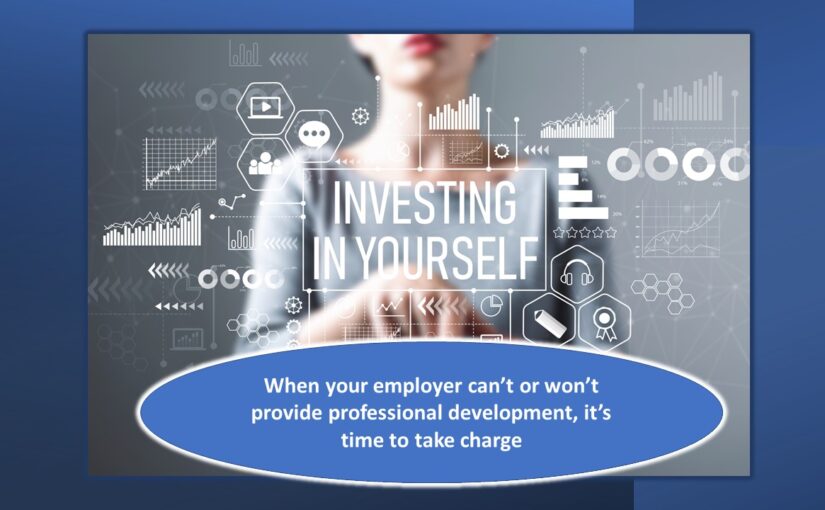By Thomas Davis, DNAP, MAE, CRNA
A common theme of my leadership articles is emphasis on the importance of creating a preferred workplace. Both healthcare and business management literature reinforce the connection between employee engagement/productivity and working in a favored environment. Among the foundational elements of a great workplace is professional development where the employer actively seeks avenues for employees to gain new professional skills.
Unfortunately, not everyone works in a preferred workplace. If your employer does not promote expansion of you career skills, you have three choices; 1) stagnate with the status quo, 2) find a new job, or 3) step up and take charge of your own professional development. For workers who are tied to their community and unable/unwilling to move, option 3 is the best choice.
When the employer can’t or won’t, step up and take charge
Personal development begins with awareness of its importance and a sincere desire to gain new knowledge and skills independently when it is not promoted in the workplace. Writing in the blog rgpm, author Elizabeth Harrin offers the following tips for starting your own personal development program.
Make self-improvement a priority. Set a goal for improving your work skills and make it specific. “I’d like to get better at” doesn’t cut it. State the new skill that you intend to develop or the current skill that you intend to improve and then follow with “as evidenced by” and state specific milestones along the pathway to accomplishing the goal.
Be the best at what you do. As busy healthcare professionals, we get into a routine workflow and robotically move through the day as efficiently as possible. Take time to reflect on what you currently do and find ways to do it better. For some it may involve organizing the workspace and for others, it may be improving interpersonal relationships with patients or colleagues. Regardless, be the best that you can be.
Solicit feedback. It is human nature to revel in praise and wilt in the face of criticism, however, self-improvement comes from a “make me better” attitude where honest feedback is important. In my practice, cataract patients are usually scheduled to return to have the second eye done. After the first eye I always ask, “when you come back, what can we do differently to make your experience better?” At the end of the day ask your perioperative team, “do you have any suggestions for things that I can do to help your workflow?” Listen, learn, and don’t push back.
Get a mentor. It may be a colleague or someone up the chain of command but there are others who are skilled at the area that you want to improve. Tap into their expertise and form a mentoring relationship with someone who truly wants to help you gain new skills. In addition to personal growth, you expand your network and may even develop a friendship that will continue throughout your career.
Become a trainer. Your employer may not have a professional development program, but they often introduce new technology to the workplace. When new equipment or computer programs are introduced, volunteer to be a super-user and be the first to master the needed skills.
Earn a degree/certification. Opportunities abound for healthcare workers to gain certification in specific areas of practice such as ultrasound guided regional anesthesia or pain management. In addition, advanced degrees including a doctorate degree are offered online and provide abundant opportunities for personal growth.
Taking charge of your future is empowering
Personal growth in the workplace often involves a series of low-key behaviors that boost your sense of self-worth and your value to the organization. Put differently, you don’t have to receive advanced training in new skills to experience personal growth. The management blog career Contessa offers additional tips for creating your own professional development plan.
Organize your life. Remove the clutter from your workspace, create a calendar with a daily block of time for self-help initiatives, then make a list of things to accomplish each day. End your day with a feeling of accomplishment as you review the items that you completed and checked off the list.
Create goals. Be realistic and ensure that your goals are both attainable and things that you will commit to accomplish. State the desired outcome and make a list of tasks that must be achieved in route to your goal.
Talk directly to management. Sometimes it’s not that they don’t want you to have professional development, rather, production pressure has kept managers too busy to focus on your needs. An honest and open discussion will let them know that you desire growth in the job and position you to be selected to manage the next project.
Ask questions and hone listening skills. Become aware of the issues that are of most concern to management and offer to help create a solution. Listen and learn.
Use positive self-talk. We constantly have an inner dialogue going and often it can take us places that drag us down. Rather than focusing on the negatives, recall the things that you do well, congratulate yourself, and visualize ways to expand those successes in other tasks. Develop an asset-based mentality with a focus on what can be done with the available resources.
Accept responsibility for your personal growth and development
In an ideal workplace, your boss, and your colleagues care about you as an individual and want you to have ongoing opportunities for improvement. If you are in such a workplace, cherish it appreciate the openings that it provides. However, if you are like many others who toil in a less than ideal workplace, free yourself from the bonds of stagnation by using the tips in this article to plan and implement your own professional development plan. Your efforts will pay big dividends as you master new skills and inspire your colleagues to follow in your footsteps. Who knows, you may be the catalyst to bring professional development into your workplace transform the organization from “just another job” to being a preferred workplace.
Tom is an experienced leader, educator, author, and requested speaker. Click here for a video introduction to Tom’s talk topics.


